

Le premier musée consacré aux musiques électroniques en Europe ouvrira cette année. Photo en Une : © MOMEM « La musique électronique a une famille, un héritage et un avenir. » Une citation de Jean-Michel Jarre, que l'on retrouve sur l'une des affiches promotionnelles du MOMEM, et qui correspond parfaitement à la ligne de conduite du musée.
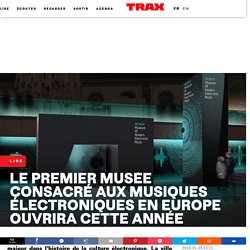
Son ouverture, initialement prévue en 2017, avait finalement été reportée. À l'initiative du projet, on retrouve Andreas Tomalla, aka Talla 2XLC – fondateur des Technoclub, les premières soirées de musique électronique à Francfort en 1984–, mais aussi Alex Azary, résident et responsable de feu le Club XS, et enfin Stefan Weil, co-fondateur de l’Atelier Markgraph. Le musée ne prévoit pas d’être assimilé à la configuration d'un musée d’art moderne ou contemporain. Il proposera une expérience unique, racontant le passé, présent et futur de la musique électronique. Le musée a néanmoins besoin de s’autofinancer, et fait donc appel aux donations. Pour d'avantage d’informations, rendez-vous sur le site du musée. Music Mouse - An Intelligent Instrument - An Emulation.
György Ligeti: Klavierweke.
Artistes. Partitions. Subventions. Databending. Databending is the alteration of raw data to influence the data's interpretation.
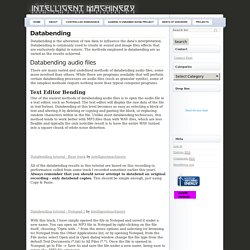
Databending is commonly used to create in sound and image files effects that are exclusively digital in nature. The methods employed in databending are as varied as the results achieved. There are many varied and undefined methods of databending audio files, some more involved than others. While there are programs available that will perform certain databending processes on audio files (such as granular synths), some of the simplest methods require nothing more than typical computer programs. Text Editor Bending One of the easiest methods of databending audio files is to open the audio file in a text editor, such as Notepad.
Granulator. Granulator What is Granulator ?
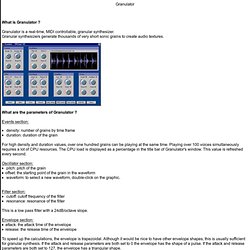
Granulator is a real-time, MIDI controllable, granular synthesizer. Granular synthesizers generate thousands of very short sonic grains to create audio textures. What are the parameters of Granulator ? Events section: density: number of grains by time frame duration: duration of the grain For high density and duration values, over one hundred grains can be playing at the same time. CD Duplication, DVD Duplication, DVD Replication, Audio Cassettes, Vinyl Record Pressing by Analogue Media ( Amtech ) in Montreal and Toronto Canada.
By MixGenius. Untitled. By Jeremy Friesner / Meyer Sound Laboratories Inc. 3/5/2009 Audio handling libraries by Erik de Castro Lopo GUI library by TrollTech Win32 CD audio ripping library by Andy Key AudioMove is a simple, easy to use GUI-based batch audio file copy-and-conversion program.
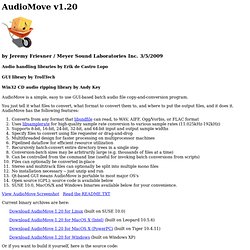
You just tell it what files to convert, what format to convert them to, and where to put the output files, and it does it. View AudioMove Screenshot Read the README.TXT. The Sound of Sorting - "Audibilization" and Visualization of Sorting Algorithms - panthema.net. Posted on 2013-05-22, last updated 2013-11-26 by Timo Bingmann at Permlink.
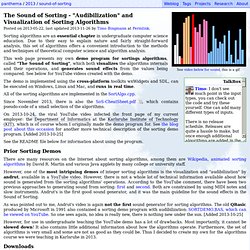
Sorting algorithms are an essential chapter in undergraduate computer science education. Due to their easy to explain nature and fairly straight-forward analysis, this set of algorithms offers a convenient introduction to the methods and techniques of theoretical computer science and algorithm analysis. This web page presents my own demo program for sortings algorithms, called "The Sound of Sorting", which both visualizes the algorithms internals and their operations, and generates sound effects from the values being compared. See below for YouTube videos created with the demo. The demo is implemented using the cross-platform toolkits wxWidgets and SDL, can be executed on Windows, Linux and Mac, and runs in real time. All of the sorting algorithms are implemented in the SortAlgo.cpp. Seaquence. Paul's Extreme Sound Stretch. By Nasca Octavian PAUL Introduction This is a program for stretching the audio.
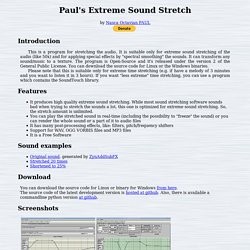
It is suitable only for extreme sound stretching of the audio (like 50x) and for applying special effects by "spectral smoothing" the sounds. It can transform any sound/music to a texture. The program is Open-Source and it's released under the version 2 of the General Public License. Please note that this is suitable only for extreme time stretching (e.g. if have a melody of 3 minutes and you want to listen it in 3 hours). Features. The Impossible Music of Black MIDI. The machine on which Conlon Nancarrow created his player piano rolls.

Photo by Carol Law, 1977. Collection: C Amirkhanian. In 1947, the composer Conlon Nancarrow—frustrated with human pianists and their limited ability to play his rhythmically complex music—purchased a device which allowed him to punch holes in player piano rolls. This technology allowed him to create incredibly complex musical compositions, unplayable by human hands, which later came to be widely recognized by electronic musicians as an important precursor to their work. A similar interest in seemingly impossible music can be found today in a group of musicians who use MIDI files (which store musical notes and timings, not unlike player piano rolls) to create compositions that feature staggering numbers of notes. Art Zoyd & Art Zoyd Studio. Label, musique à l'image et audio branding. Songs that sounds like other songs. How Many Hours a Day Should You Practice? — The Bulletproof Musician.